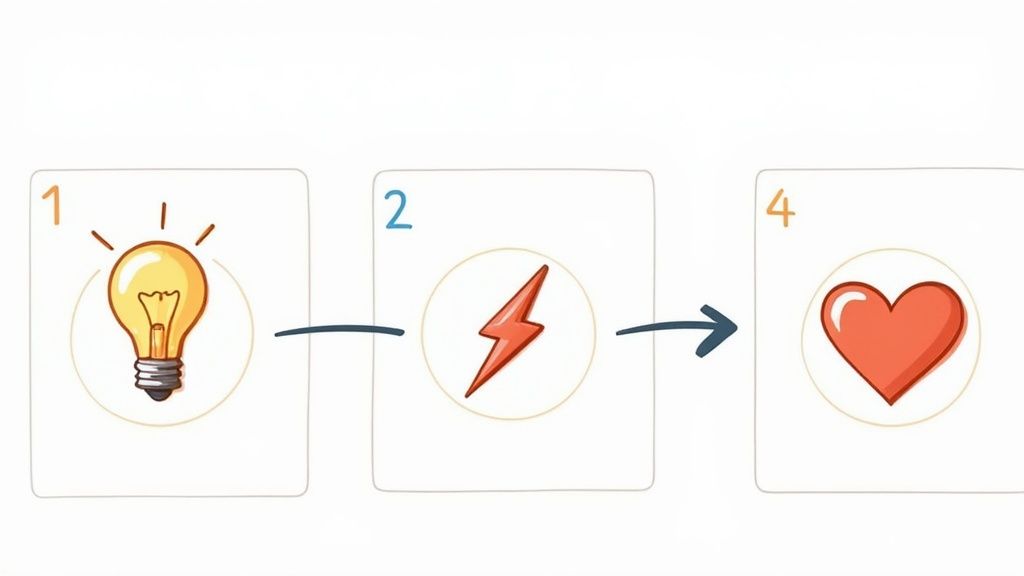Top Strategies for Producing an Effective Corporate Video



Top Strategies for Producing an Effective Corporate Video
In a content-saturated landscape, a mediocre corporate video is worse than no video at all; it's a missed opportunity. The days of sterile, self-promotional videos that talk at, rather than to, an audience are over. The modern corporate video is a powerful tool for connection, education, and conversion, but only when executed with precision and purpose. Finding success requires a deep understanding of your audience, a commitment to authentic storytelling, and a data-driven approach to optimization.
The core challenge lies in shifting from merely creating content to engineering a strategic asset. The process of producing an effective corporate video is less about expensive gear and more about a robust framework that guides every decision, from initial concept to final distribution. This is especially true when considering the nuances of different platforms. To truly grasp the scope of effective corporate video, for instance, consider external resources on mastering video marketing for social media, where format and tone are critical.
This article moves beyond generic advice to provide a comprehensive roundup of eight foundational strategies. Each one is a critical pillar in building videos that not only capture attention but also drive measurable business results. We will explore the specific, actionable steps to elevate your production process, ensuring every frame contributes to your brand's growth and impact. This blueprint will help you transform your video content from a simple checklist item into a cornerstone of your marketing engine, delivering tangible returns and building lasting audience relationships.
1. Define Clear Objectives and Target Audience
The most critical first step in producing an effective corporate video is a strategic one: defining precisely what you want to achieve and who you need to reach. Without this foundational clarity, even the most beautifully produced video will fail to deliver a return on investment. This strategy involves setting specific, measurable goals and developing a deep, empathetic understanding of your intended viewers, ensuring every creative decision serves a distinct business purpose.

Before diving into production, ensure your corporate video aligns with a solid effective communication plan and strategy, as this documented approach will guide your efforts and keep the entire team aligned. Think of your objective as your destination and your audience profile as your map; you need both to arrive at your goal successfully.
How to Implement This Strategy
Start by asking a fundamental question: What action do we want the viewer to take after watching? The answer will shape your video's core objective, which could be anything from increasing brand awareness and generating qualified leads to improving employee engagement or educating customers.
Next, create detailed audience personas. Go beyond basic demographics and explore psychographics: What are their pain points? What motivates them? Where do they consume content online? This deep dive ensures your message, tone, and style resonate authentically. For example, HubSpot’s educational video series is a masterclass in this, creating separate content for viewers at different stages of the buyer’s journey, from awareness to decision.
Key Insight: A video designed for everyone is a video designed for no one. Hyper-targeting your content to a specific audience persona dramatically increases its impact and effectiveness.
Actionable Tips for Success
- Set SMART Goals: Make your objectives Specific, Measurable, Achievable, Relevant, and Time-bound. For instance, "Generate 150 MQLs from the video campaign in Q3" is much stronger than "Get more leads."
- Conduct Audience Research: Use surveys, customer interviews, and social media analytics to build data-backed personas. Analyze competitor videos to see what engages their audience.
- Align Content with the Funnel: Is your video for top-of-funnel awareness (like Dove's 'Real Beauty' campaign), mid-funnel consideration, or bottom-of-funnel conversion? The goal dictates the creative approach.
- Document Everything: Create a video brief that clearly outlines the objectives, target audience, key message, and success metrics. This document is essential for keeping your creative team, stakeholders, and production partners aligned.
2. Craft Compelling Storytelling and Narrative Structure
Once you know your objective and audience, the next strategy is to move beyond dry facts and figures by weaving your message into an engaging narrative. Humans are hardwired for stories; a compelling plot with relatable characters and emotional stakes will make your corporate message dramatically more memorable and persuasive. This approach transforms a standard promotional piece into a powerful communication tool that builds a genuine connection with your viewers.

Effective storytelling involves structuring your video with a clear beginning, middle, and end, incorporating elements like conflict, rising action, and resolution. Rather than simply listing your product’s features, you present a problem (the conflict) that your audience faces and position your brand as the guide that helps them achieve a successful outcome (the resolution). To deepen your understanding of this technique, explore more about corporate storytelling, as mastering this art can set your video content apart from the competition.
How to Implement This Strategy
Begin by identifying the core conflict your target audience experiences. This is the central problem or pain point that your product or service solves. Frame this challenge as the "villain" of your story. Your customer then becomes the "hero," and your brand takes on the role of the "mentor" or "guide" who equips the hero with the tools they need to succeed. This framework, popularized by Donald Miller’s StoryBrand, simplifies complex messages and makes them resonate on a personal level.
Consider Airbnb's 'Belong Anywhere' campaign, which doesn't just show properties; it tells the stories of hosts and guests connecting, turning a transactional service into a narrative about human connection and community. Similarly, Patagonia’s documentaries focus on environmental activism, positioning the brand as a guide in the larger story of protecting our planet, which powerfully resonates with its target audience. These are prime examples of leveraging storytelling in a corporate video.
Key Insight: People don't remember data; they remember stories. When you frame your company’s solution within a narrative, you anchor your message in the viewer’s memory and emotions, fostering brand loyalty.
Actionable Tips for Success
- Hook Them Immediately: The first 5-10 seconds are critical. Start with an intriguing question, a surprising statistic, or an emotionally charged visual that introduces the story’s central conflict.
- Show, Don't Tell: Instead of saying your software improves efficiency, show a character struggling with disorganized chaos before transforming their workflow with your tool. Visual evidence is more powerful than claims.
- Feature Real People: Incorporate authentic customer testimonials or employee stories. Real-life narratives provide social proof and make your story more relatable and trustworthy.
- End with a Clear Resolution: The story should conclude with the hero (your customer) achieving success. This resolution should directly tie into your video’s primary call-to-action, showing the viewer the positive outcome they can expect.
3. Optimize for Platform-Specific Distribution
Creating a brilliant video is only half the battle; ensuring it performs optimally wherever it's seen is equally crucial. This strategy involves tailoring your corporate video’s format, length, style, and messaging for the specific platforms where your audience consumes content. A one-size-fits-all approach no longer works in a fragmented digital landscape where user behavior and technical requirements vary drastically from LinkedIn to TikTok.
Effective distribution means treating each platform as a unique channel with its own culture and algorithm. By adapting your content to fit these native environments, you significantly increase its reach, engagement, and overall impact. For a deeper understanding of this approach, explore these best practices for video marketing, which emphasize tailoring content to the channel for maximum effectiveness.
How to Implement This Strategy
Begin by analyzing where your target audience is most active. Instead of posting the same 16:9 video everywhere, plan your production to create multiple cuts and formats from a single shoot. This "content atomization," a concept championed by figures like Gary Vaynerchuk, allows you to create a high-volume of platform-native assets efficiently.
For example, a comprehensive customer testimonial video produced for your website (16:9 aspect ratio) can be repurposed into several distinct assets. You could create a professional, 60-second square video with bold captions for LinkedIn, a fast-paced, vertical 15-second clip for Instagram Stories highlighting a key quote, and a slightly longer, more detailed cut for YouTube with chapter markers. BuzzFeed excels at this, producing content specifically for the vertical, ephemeral nature of platforms like TikTok.
Key Insight: Don’t just post your video on a platform; create a video for the platform. The most successful content feels native to the user experience, respecting the audience’s expectations for that specific channel.
Actionable Tips for Success
- Create Multiple Aspect Ratios: During post-production, create versions in 16:9 (YouTube, website), 1:1 (LinkedIn, Instagram feed), and 9:16 (Instagram Reels, TikTok, YouTube Shorts).
- Add Captions by Default: A majority of social media videos are viewed with the sound off. Burned-in, stylized captions are essential for accessibility and capturing attention in a silent feed.
- Optimize the First 3 Seconds: Attention spans are shortest on social feeds. Ensure your opening frame is visually compelling and your core message is delivered immediately.
- Leverage Platform-Specific Features: Use features like Instagram's interactive stickers, YouTube's end screens and chapter markers, or LinkedIn's document-sharing feature to boost engagement in a native way.
4. Implement Professional Production Quality
While a compelling story is vital, its impact can be completely undermined by poor execution. Implementing professional production quality means upholding a broadcast-level standard across all technical aspects of your video, from visuals and audio to editing and color. This strategy ensures your final product not only captures attention but also reflects the high standards of your brand, building trust and credibility with your audience.

In today's content-saturated world, viewers have high expectations shaped by professional creators and cinematic productions. A shaky camera, muffled audio, or amateurish editing can cause them to click away instantly. Committing to quality is an investment in your brand's perception, signaling that you value excellence in everything you do.
How to Implement This Strategy
Achieving professional quality starts with pre-production planning and carries through every stage. This involves more than just having a good camera; it's about using the right equipment and techniques to create a polished final product. Before filming, develop detailed shot lists and storyboards to guide your camera operators and ensure you capture all necessary footage efficiently.
The difference between amateur and professional video often comes down to lighting and sound. Use a three-point lighting setup (key, fill, and back light) to create depth and eliminate harsh shadows. For audio, never rely on a camera's built-in microphone. Instead, use external lavalier or boom mics to capture crisp, clear sound. For example, Apple's product launch videos are renowned for their cinematic quality, using masterful lighting, sharp focus, and flawless audio to make their products look premium and desirable. For complex projects, it's often wise to partner with one of the best corporate video production companies to ensure a high-end result.
Key Insight: Audio is more than half the video. Viewers will tolerate mediocre visuals with great audio, but they will not tolerate great visuals with poor audio.
Actionable Tips for Success
- Invest in Quality Audio Equipment: Prioritize external microphones. A dedicated audio recorder and lavalier mics are essential for interviews and testimonials to ensure your message is heard clearly.
- Plan Your Shots: Use storyboards and shot lists to visualize the video beforehand. This ensures a more dynamic and visually interesting final cut, avoiding static, uninspired framing.
- Master Professional Lighting: Learn and apply the principles of three-point lighting. Good lighting can make even a smartphone camera look more professional and flattering.
- Embrace Polished Post-Production: Use professional editing software to create a seamless flow. Apply color grading to establish a consistent mood and reinforce your brand's visual identity.
- Test on Multiple Devices: Before publishing, check your video's audio and visual quality on a phone, tablet, and desktop monitor to ensure a consistent, high-quality experience for all viewers.
5. Focus on Authentic Employee and Customer Stories
One of the most powerful strategies for producing an effective corporate video is to shift the spotlight from polished corporate messaging to the real people your business impacts. This approach leverages authentic testimonials, case studies, and behind-the-scenes content featuring genuine employees and customers. By showcasing their unscripted experiences, you build a level of trust, credibility, and emotional connection that slick advertising simply cannot replicate.
This strategy moves beyond telling your audience how great you are and instead shows them through the eyes of those who matter most. When featuring authentic customer stories, applying expert testimonial video production tips will ensure high-quality and impactful results that truly resonate. This method transforms your corporate video from a monologue into a powerful, peer-driven conversation.
How to Implement This Strategy
The core of this strategy is identifying and empowering your brand's best advocates: your happy customers and passionate employees. Begin by pinpointing individuals who have compelling stories that align with your video's objectives. For a customer story, this could be someone who achieved remarkable success using your product. For an employee video, it might be a team member whose journey embodies your company's culture and values.
Instead of a rigid script, prepare a set of guiding questions or talking points that encourage natural, conversational storytelling. The goal is to capture genuine emotion and specific, relatable details. For instance, Zappos became legendary for its employee culture videos that weren't heavily produced but offered an authentic glimpse into the workplace, while Salesforce built its brand on powerful customer success stories that showcase real-world impact. Great employee testimonial videos do the same, building trust from the inside out.
Key Insight: Authenticity is the new currency of trust. Viewers are more likely to believe and connect with a real person's unpolished story than a perfectly scripted corporate pitch.
Actionable Tips for Success
- Prepare, Don't Script: Provide your subjects with key themes or questions beforehand, but encourage them to speak in their own words. This prevents the interview from sounding robotic.
- Show, Don't Just Tell: Capture B-roll footage of your subjects in their natural environment-a customer using your product at their office or an employee collaborating with their team. This visual context makes their story more believable and engaging.
- Focus on Specific Outcomes: Guide your subjects to talk about concrete, measurable benefits. "We increased efficiency by 40%" is far more impactful than "It made things better."
- Ensure Legal Compliance: Always obtain signed video release forms from every person featured. This is a non-negotiable step to protect both your company and the individual.
6. Incorporate Strong Call-to-Action and Lead Generation
A corporate video without a clear next step is a missed opportunity. This strategy ensures your video actively contributes to business goals by integrating compelling calls-to-action (CTAs) that guide viewers toward a specific, desired behavior. It’s about transforming passive viewership into active engagement, turning your video from a simple communication tool into a powerful lead-generation engine that delivers measurable results.
A video's purpose is rarely just to be seen; it's to inspire action. By strategically placing CTAs and creating a seamless path to conversion, you can effectively leverage your video content. This approach is fundamental to maximizing ROI and is a core component of using video for lead generation, ensuring your creative investment translates directly into business growth.
How to Implement This Strategy
The key is to make the desired action obvious, easy, and compelling. Your CTA should be a natural extension of the video's message. For instance, if your video demonstrates a complex software feature, the logical next step is to offer a personalized demo. If it tells an inspiring customer success story, offering a free trial or a case study download makes perfect sense.
Consider the entire user journey. Where does the viewer go after clicking? The landing page must be a seamless continuation of the video experience, with consistent messaging, branding, and a clear, simple form. For example, Shopify excels at this by featuring entrepreneur stories that end with a direct CTA to "Start your free trial," leading to a landing page that mirrors the video's empowering tone and visuals. Similarly, Zoom's feature demonstrations often conclude with a simple "Request a Demo" button.
Key Insight: The call-to-action isn't just an afterthought tacked on at the end; it should be integrated into the video's narrative and designed to solve the viewer's problem or satisfy the curiosity your content created.
Actionable Tips for Success
- Use Action-Oriented Language: Start your CTAs with strong verbs like "Download," "Register," "Discover," or "Start." This direct language leaves no room for ambiguity.
- Create Urgency: Motivate immediate action by incorporating scarcity or exclusivity, such as "Register for our webinar, spots are limited" or "Download your exclusive guide now."
- Test and Optimize: Don't assume your first CTA is the best. A/B test different wording, colors, placements (mid-roll vs. end-screen), and formats (buttons, verbal cues, on-screen text) to see what drives the highest conversion rate.
- Align Landing Pages: Ensure your landing page headline, copy, and offer directly match what was promised in the video. Any disconnect will cause friction and reduce conversions.
7. Leverage Data Analytics and Performance Measurement
Creating a compelling video is only half the battle; understanding its impact is what drives long-term success. Leveraging data analytics involves systematically tracking and measuring your video's performance to understand audience behavior and optimize future content. This strategy transforms video production from a creative-only exercise into a data-informed business function, ensuring your efforts contribute directly to your bottom line.
Without measurement, you're essentially guessing what works. By implementing a robust analytics framework, you can move from assumptions to evidence-based decisions, continuously refining your approach for producing an effective corporate video. This turns each video into a learning opportunity, compounding your marketing intelligence over time.
How to Implement This Strategy
The first step is to choose a video hosting platform with powerful analytics capabilities. Platforms like Wistia, Vidyard, and even YouTube’s advanced analytics offer deep insights that go far beyond simple view counts. These tools provide viewer heatmaps, engagement graphs, and drop-off rates, showing you exactly which parts of your video hold attention and where viewers lose interest.
Next, define the Key Performance Indicators (KPIs) that align directly with the objectives you set in the first phase. If your goal was lead generation, your primary KPI is the conversion rate on your video's call-to-action. If the goal was brand awareness, you might focus on metrics like play rate, social shares, and overall watch time. For example, Wistia’s heatmaps can reveal if viewers are re-watching a specific product feature demonstration, indicating high interest or potential confusion that needs clarification.
Key Insight: Metrics like view count are vanity metrics. Focus on engagement data like watch time, audience retention, and click-through rate, as these are the true indicators of an effective corporate video.
Actionable Tips for Success
- Align Metrics with Objectives: Don't get lost in data. If your goal is training, completion rate is key. If it's marketing, focus on lead-form submissions or clicks on your CTA.
- Track Engagement Hotspots and Drop-offs: Use engagement graphs and heatmaps to identify which segments resonate and where viewers stop watching. This insight is invaluable for scripting future videos.
- Use UTM Parameters: When sharing your video across different channels (email, social media, paid ads), use unique UTM tracking codes to pinpoint which sources drive the most engaged traffic and conversions.
- A/B Test Thumbnails and Titles: Small changes can have a huge impact on play rate. Test different thumbnail images, titles, and video player colors to see what encourages more clicks.
- Establish Regular Reporting: Create a simple dashboard or a monthly report to review performance against your goals. Use these review sessions to plan improvements for your next video production cycle.
8. Ensure Brand Consistency and Visual Identity
An effective corporate video doesn't exist in a vacuum; it acts as an ambassador for your brand. This strategy involves embedding your company’s unique visual and tonal identity into every frame of your video content. By consistently applying brand elements like logos, color palettes, fonts, and messaging, you build a cohesive and instantly recognizable presence that strengthens brand recall and fosters trust with your audience.
This goes beyond simply placing your logo at the end of the video. It's about creating an immersive brand experience, where every visual and auditory element feels authentically yours. Whether a viewer sees your video on LinkedIn, your website, or at a trade show, they should immediately connect it back to your company, reinforcing your brand’s position in their mind.
How to Implement This Strategy
The foundation of this strategy is a comprehensive set of video-specific brand guidelines. This document serves as the single source of truth for your internal team and external production partners, dictating exactly how your brand should be represented on screen. It eliminates guesswork and prevents the common pitfall of producing videos that feel disconnected from your other marketing materials.
For example, Apple's product videos are a masterclass in brand consistency. Their minimalist aesthetic, clean backdrops, specific font usage, and deliberate pacing are instantly recognizable. They don't need to shout their brand name; the visual language does it for them. Similarly, Coca-Cola consistently weaves its signature red color and themes of happiness and togetherness into all video campaigns, creating a powerful, uniform brand narrative.
Key Insight: Brand consistency in video isn't about restriction; it's about recognition. A strong, consistent visual identity makes your content more memorable and builds brand equity with every view.
Actionable Tips for Success
- Create Video Brand Guidelines: Develop a formal document outlining logo usage (clear space, sizing), primary and secondary color palettes (HEX codes), approved typography, and motion graphic styles.
- Develop Reusable Templates: Build standardized templates in your editing software for common video formats like interviews, tutorials, or social media clips. Include pre-set lower thirds, title cards, and end screens.
- Maintain a Consistent Brand Voice: Ensure your scripts, on-screen text, and narrator’s tone align with your overall brand personality, whether it's professional and authoritative like IBM or energetic and inspiring like Nike.
- Conduct Regular Audits: Periodically review your library of video content to check for compliance with brand standards. This helps identify and correct any inconsistencies that may have emerged over time.
8-Point Strategy Comparison Guide
From Strategy to Success: Your Next Steps in Corporate Video Production
The journey from a simple idea to a high-impact corporate video is paved with strategic decisions. As we've explored, producing an effective corporate video is less about a single moment of creative genius and more about a systematic, integrated process. It's about transforming abstract goals into tangible assets that resonate with your audience and deliver measurable business value. The eight strategies outlined in this guide are not just a checklist; they are the foundational pillars of a successful video content engine.
Mastering this framework means moving beyond the "what" of video creation, like cameras and editing software, to the "why" and "how". It’s understanding that a video without clear objectives is like a ship without a rudder, and a story without an authentic voice will fail to connect, no matter how high the production value.
Recapping Your Blueprint for Success
Let's distill the core principles we've covered into a cohesive action plan. True effectiveness is born from the synergy of these elements working in concert:
- Strategic Foundation: Your efforts must begin with clear objectives and a deep understanding of your target audience. Every subsequent decision, from narrative to distribution, must align with this initial strategic vision.
- Creative Core: A compelling narrative structure and authentic stories from employees or customers are what capture attention and build emotional connections. This is the heart of your video, turning viewers into advocates.
- Technical Excellence: Professional production quality and a consistent brand identity are non-negotiable. These elements build credibility and ensure your message is received without distraction, reinforcing your brand's professionalism.
- Performance and Growth: Your video's life cycle doesn't end on export. Platform-specific optimization, strong calls-to-action, and a commitment to data analytics are what turn a creative piece into a performance-driving tool.
Think of these strategies not as isolated steps but as an interconnected ecosystem. A strong story is amplified by high-quality production. A clear call-to-action is only effective if the video reaches the right audience on the right platform. And analytics provide the crucial feedback loop to refine your strategy for the next project.
The Path Forward: From Knowledge to Action
The ultimate takeaway is that an effective corporate video is an engineered asset, not a happy accident. It requires a deliberate fusion of art and science, creativity and data. The value of mastering these concepts is profound; it empowers you to create content that doesn't just look good but actively works to build brand equity, generate leads, and drive revenue.
Key Insight: The most impactful corporate videos are born when strategic planning, authentic storytelling, technical proficiency, and data-driven optimization are treated as equally critical components of a single, unified process.
This holistic approach is what separates fleeting content from enduring brand assets. Implementing this entire blueprint, from initial scripting and storyboarding to complex animation, multi-platform distribution, and performance tracking, can be a significant undertaking. It demands a diverse range of skills that many in-house teams, especially at startups and scale-ups, may not possess. Managing freelance talent for each stage adds another layer of complexity and administrative overhead.
For marketing leaders and founders who need to execute these high-level strategies for producing an effective corporate video without the burden of building a massive internal department, a dedicated creative partner offers a powerful and streamlined solution. The key is to find a partner who can manage the entire ecosystem for you, providing the strategic guidance and diverse creative talent needed to bring this comprehensive vision to life, project after project. By internalizing these strategies, you are now equipped to lead your organization’s video efforts with confidence, ensuring every frame you produce serves a purpose and pushes your business forward.
Are you ready to implement these strategies without the operational drag of hiring and managing a complex creative team? Moonb provides a full-service, on-demand creative department, giving you instant access to the diverse expertise needed to execute this entire video production blueprint. Transform your vision into a powerful business asset by visiting Moonb to see how our model can streamline your creative output.






